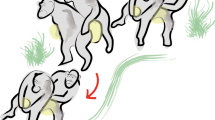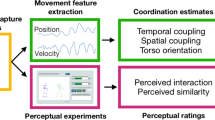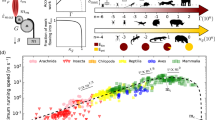Abstract
Dance is believed to be important in the courtship of a variety of species, including humans, but nothing is known about what dance reveals about the underlying phenotypic—or genotypic—quality of the dancer1,2,3,4,5,6. One measure of quality in evolutionary studies is the degree of bodily symmetry (fluctuating asymmetry, FA), because it measures developmental stability7,8. Does dance quality reveal FA to the observer and is the effect stronger for male dancers than female? To answer these questions, we chose a population that has been measured twice for FA since 1996 (ref. 9) in a society (Jamaican) in which dancing is important in the lives of both sexes. Motion-capture cameras created controlled stimuli (in the form of videos) that isolated dance movements from all other aspects of visual appearance (including FA), and the same population evaluated these videos for dancing ability. Here we report that there are strong positive associations between symmetry and dancing ability, and these associations were stronger in men than in women. In addition, women rate dances by symmetrical men relatively more positively than do men, and more-symmetrical men value symmetry in women dancers more than do less-symmetrical men. In summary, dance in Jamaica seems to show evidence of sexual selection and to reveal important information about the dancer.
This is a preview of subscription content, access via your institution
Access options
Subscribe to this journal
Receive 51 print issues and online access
$199.00 per year
only $3.90 per issue
Buy this article
- Purchase on Springer Link
- Instant access to full article PDF
Prices may be subject to local taxes which are calculated during checkout


Similar content being viewed by others
References
Darwin, C. R. The Descent of Man and Selection in Relation to Sex (D. Appleton and Company, New York, 1871/1896)
Brønseth, T. & Folstad, I. The effect of parasites on courtship dance in threespine sticklebacks: More than meets the eye? Can. J. Zool. 75, 589–594 (1997)
Singer, F. et al. Analysis of courtship success in the funnel-web spider Agelenopsis aperta. Behaviour 137, 93–117 (2000)
Rintamaki, P. T., Alatalo, R. V., Hoglund, J. & Lundberg, A. Fluctuating asymmetry and copulation success in lekking black grouse. Anim. Behav. 54, 265–269 (1997)
Hanna, J. L. Dance, Sex, and Gender: Signs of Identity, Dominance, Defiance, and Desire (Univ. of Chicago Press, Chicago, 1988)
Grammer, K., Keki, V., Striebel, B., Atzmueller, M. & Fink, B. in Evolutionary Aesthetics (eds Voland, E. & Grammer, K.) 295–324 (Springer, Heidelberg, 2003)
Polak, M. (ed.) Developmental Instability: Causes and Consequences (Oxford Univ. Press, New York, 2003)
Møller, A. P. & Swaddle, J. P. Developmental Stability and Evolution (Oxford Univ. Press, Oxford, 1997)
Trivers, R., Manning, J. T., Thornhill, R., Singh, D. & Mcguire, D. Jamaican Symmetry Project: Long-term study of fluctuating asymmetry in rural Jamaican children. Hum. Biol. 71, 417–430 (1999)
Van Valen, L. A study of fluctuating asymmetry. Evolution 16, 125–142 (1962)
Waddington, C. H. The Strategy of the Genes (Macmillan, New York, 1957)
Martin, J. & Lopez, P. Hindlimb asymmetry reduces escape performance in the lizard Psammodromus algirus. Physiol. Biochem. Zool. 74, 619–624 (2001)
Møller, A. P., Sanotra, G. S. & Vestergaard, K. S. Developmental instability and light regime in chickens (Gallus gallus). Appl. Anim. Behav. Sci. 62, 57–71 (1999)
Swaddle, J. P. Within-individual changes in developmental stability affect flight performance. Behav. Ecol. 8, 601–604 (1997)
Garland, T. Jr & Freeman, P. W. Selective breeding for high endurance running increases hindlimb symmetry. Evolution 59, 1851–1854 (2005)
Gummer, D. L. & Brigham, R. M. Does fluctuating asymmetry reflect the importance of traits in little brown bats (Myotis lucifugus)? Can. J. Zool. 73, 990–992 (1995)
Moodie, G. E. E. Meristic variation, asymmetry, and aspects of the habitat of Culea inconstans (Kirtland), the brook stickleback, in Manitoba. Can. J. Zool. 55, 398–404 (1977)
Manning, J. T. & Ockenden, L. Fluctuating asymmetry in racehorses. Nature 370, 185–186 (1994)
Manning, J. T. & Pickup, L. J. Symmetry and performance in middle distance runners. Int. J. Sports Med. 19, 205–209 (1998)
Thornhill, R. & Gangestad, S. The scent of symmetry: A human sex pheromone that signals fitness? Evol. Hum. Behav. 20, 175–201 (1999)
Hughes, S. M., Harrison, M. A. & Gallup, G. G. The sound of symmetry: voice as a marker of developmental instability. Evol. Hum. Behav. 23, 173–180 (2002)
Gangestad, S. W., Thornhill, R. & Yeo, R. A. Facial attractiveness, developmental stability, and fluctuating asymmetry. Ethol. Sociobiol. 15, 73–85 (1994)
Palmer, A. R. Detecting publication bias in meta-analyses: A case study of fluctuating asymmetry and sexual selection. Am. Nat. 154, 220–233 (1999)
Josefsson, T., Nordh, E. & Eriksson, P. O. A flexible high-precision video system for digital recording of motor acts through lightweight reflex markers. Comput. Methods Programs Biomed. 49, 119–129 (1996)
Nagata, N., Okumoto, K., Iwai, D., Toro, F. & Inokuchi, S. Analysis and synthesis of Latin dance using motion capture data. Lect. Notes Comput. Sci. 3333, 39–44 (2004)
Kellner, J. & Alford, R. A. The ontogeny of fluctuating asymmetry. Am. Nat. 161, 931–947 (2003)
Trivers, R. in Sexual Selection and the Descent of Man 1871–1971 (ed. Campbell, B.) 136–179 (Aldine Publishing, Chicago, 1972)
Little, A. C., Burt, D. M., Penton-Voak, I. S. & Perrett, D. I. Self-perceived attractiveness influences human female preferences for sexual dimorphism and symmetry in male faces. Proc. R. Soc. Lond. B 268, 39–44 (2001)
Hamilton, W. D. & Zuk, M. Heritable true fitness and bright birds: a role for parasites? Science 218, 384–387 (1982)
Palmer, A. R. & Strobeck, C. Fluctuating asymmetry: Measurement, analysis and pattern. Annu. Rev. Ecol. Syst. 17, 391–421 (1986)
Acknowledgements
We thank the Jamaican Ministry of Education and Culture for permission to conduct research. We are grateful for assistance from teachers, principals, parents, students, M. Cuff, B. Dunham, N. Sutherland and D. Zaatari. Financial support was provided by Rutgers University, the University of Washington Animation Labs, the Ann and Gordon Getty Foundation, the Rutgers Center for Human Evolutionary Studies, the Biosocial Research Foundation, and NSF grants awarded to L.C., Z.P. and R.T. W.M.B. was supported by an NSERC (Canada) postdoctoral fellowship.
Author information
Authors and Affiliations
Corresponding author
Ethics declarations
Competing interests
Reprints and permissions information is available at npg.nature.com/reprintsandpermissions. The authors declare no competing financial interests.
Supplementary information
Supplementary Figure 1
Location of eight motion-capture cameras. Camera number 7 is ceiling mounted (see image of ceiling mounted Vicon camera inset). The 2-metre squared space is the area in which a dancer was permitted to move during motion-capture (see image of subject). (PDF 55 kb)
Supplementary Figure 2
Location of lightweight reflective surface markers. The Vicon camera units emit infrared beams that are reflected off the surface markers back to the units (PDF 89 kb)
Supplementary Movie 1
Narrated demonstration of how Vicon equipment was used. (MOV 11331 kb)
Supplementary Movie 2
Symmetrical male’s dance motion-captured. (MOV 4906 kb)
Supplementary Movie 3
Asymmetrical male’s dance motion-captured. (MOV 5024 kb)
Supplementary Methods
Supplementary Methods nature04334-s6.pdf Additional details of the methods used in this study. (PDF 106 kb)
Rights and permissions
About this article
Cite this article
Brown, W., Cronk, L., Grochow, K. et al. Dance reveals symmetry especially in young men. Nature 438, 1148–1150 (2005). https://doi.org/10.1038/nature04344
Received:
Accepted:
Issue Date:
DOI: https://doi.org/10.1038/nature04344
This article is cited by
-
Multimodal Integration of Dynamic Audio–Visual Cues in the Communication of Agreement and Disagreement
Journal of Nonverbal Behavior (2014)
Comments
By submitting a comment you agree to abide by our Terms and Community Guidelines. If you find something abusive or that does not comply with our terms or guidelines please flag it as inappropriate.



